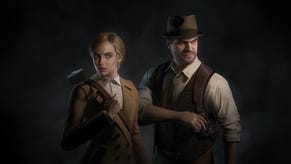A Dozen Or So Hours With: Civilization V
'Art Deco' is basically the only school of design I'm at all familiar with. My own approach to design in any regard doesn't go any further than "make most of the colours the same." So when I see something that's Art Deco, I become slightly excited. I recognised a thing that I know! I can sound very vaguely learned! So has it been with Civilization V, a beta build of which I've cuddled up to over the last few weeks. "The menus are Art Deco," I say whenever anyone asks me what the game is like. Then I nod wisely. Then they ask me about hexagons, and I punch them in the teeth.
Put this in your bloody pipe and smoke it, because if I read one more "hex appeal" gag I'm going to storm off the internet in a huff. Yes, Civ 5 includes hexes - but they're turned off by default. As in, the hex outline isn't visible, even though the game always remains laid-out in hexes.
Honestly, although it's primarily a change in the angles units can attack from, you don't need to see them, most people won't bother with the outlines, and I left them on for about five minutes before realising they didn't make a profound amount of difference to how I played the game, bar making a very pretty world look over-cluttered. Gone, forgotten, fine. Civ V is Civ: it's not some strange and super-hardcore grand-strategy rethink of the series. You will not be thinking "aaargh hexes hexes it's all hexes." It feels natural, and you will adapt almost immediately.
Probably. Most of you. Some of you won't. Of course some of you won't. I didn't find it jarring or a problem, but I appreciate I am not as resolute on game-change as some of this wonderful series' long-term fans.
There are major changes to all kinds of elements, but there's no way you'd ever mistake if for anything other than a Civ game. This is good! It is also bad! Maybe. A little. Not much, though.
My standard argument, apart from panicking that someone might ask me to explain what I mean by 'art deco', is that this early build of Civ V is genuinely, definitely lovely and, as per series' tradition, I happily swam in its slow-moving river for hour after hour. Buuuuuuut... I didn't experience the invigorating rush I did the first time I ever fired up Civ IV.
Civ IV hasn't particularly aged graphically, which is one reason why Civ V might be a harder sell than usual. It has, however, aged in terms of interface - it's just a little too cluttered and Windows 95y by 2010 standards now. At the time, though: Oh My God. The sense of freshness, of modernity, of opulence and of someone having really taken the time to reinvent a decade-old game for a new audience was unbelievable. From the first strains of Lion King music to the first Nimoyian utterance, it was like a glass of cool water in the face on a boiling hot day.
Plus it had Spock pretending to be a satellite. I don't believe I've ever laughed harder:
Civ V doesn't have that immediate, This Is A New Dawn glee-shock. I don't know if any Civ V could do that, outside of moving to something like Microsoft Surface. I'm not convinced there's much need - yet - to go far beyond what Civ IV did. Which is not to say that I would ever have refused Civ V. Someone would have to shoot me in the eyes to achieve that. It's also not to say I'm going back to Civ IV; Civ V is far prettier, and the changes do make it an enticingly different experience. I will be playing the final version for weeks at the very least; I have no doubt about that.
Plus, of course, the menus are all Art Deco. Art Deco is an eclectic artistic and design style which had its origins in Paris in the first decades of the 20th century. Nowadays the style is said to have been active from around 1910 until the outbreak of World War II. The style was named in the 1960s after the 1925 Exposition Internationale des Arts Décoratifs et Industriels Modernes that was the culmination of high-end style moderne in Paris. Led by the best designers in the decorative arts such as fashion, and interior design, Art Deco affected all areas of design throughout the 1920s and 1930s, including architecture and industrial design, as well as the visual arts such as painting, the graphic arts and film. At the time, this style was seen as elegant, glamorous, functional and modern.
I definitely wrote all of that off the top of my head. Definitely.
Civ V's major goal - and another reason why having announced it by showing off the hex thing was massively counter-productive on the marketeers' part - is to streamline Civ's multifarious systems. It's not making the game less complicated as such, but more trying to amplify certain key concepts; add more depth to them rather than simply have a bit of everything.
Notable casualties include religion and unit-stacking. I'll let that sink in for a moment.
...
You OK? Need a hug?
It's alright. I promise. It's different, but it's not especially distressing in practice. I miss religion most, and to the point that if I squint a bit I can picture an expansion pack-shaped hole in the game. Or maybe not, as what they've done is try to build the raw concept of religion into over state and society ethos. Rather than having religions be a defining reflection of a city or civilization's nature, it's now more that the overall civilizations have differing social attitudes dependent on how broadly religious you want them to be. So rather than trying to specifically create, say, a Jewish nation, you can pursue piousness, or you could pursue monarchy. Or you can pursue both. But if you try to pursue both piousness and liberalism you'll struggle. All of this is done through, essentially, a second tech tree, which is unlocked as your civilization pumps out more culture.
It's less nebulous than the old way - the effects of being more or less religious spelled out clearly, rather than splintered between an array of different faiths that can unlock a slew of different but similar upgrades. You pursue a generalised social ethos, and that can involve being a despot, or a benevolent environmentalist, or a feudal faith-head, or a combination of them all. Cultural victory is accomplished by completing six of the social tech trees, but instead you could cherry-pick the most useful (to you) policies from all over them as a helping hand to another type of victory.
The loss of religion will annoy people, there is no doubt about that. But I honestly think it's more reflective of how religion works in society than the bitty, fiddly multi-faith approach of before. It's not a magic bit bolted onto the side: it absolutely underpins a culture's attitude to itself and to the world.
Plus, I like that developing my nation's socio-political structure is now an ongoing strategy, with a specific goal in mind, rather than constituting sudden hard-shifts to something that offers a more useful bonus. Though I do miss the old games' revolutions whenever you did a sudden about-face on your fundamental approach to human existence. Thousands of tiny voices yelling 'WTF?'
Let's move on to the unit stacking. This means you won't get repeatedly ganked by a massive travelling army of invisible-until-it's-too-late units; on the other hand, it's harder to be a massive travelling army, which makes epic city invasions simultaneously more and less complicated. You have to surround stuff rather than swarm at it, with each unit's chances of success clearly labelled. Some will cry that this is dumbed down, but I think in its way its a distillation to forward-thinking strategy rather than defaulting to might makes right.
A single ranged unit microed in out and out of range can make all the difference, for instance. You have to think about what your assault is, not simply how big'n'fat it is. That's where those (TURNED OFF BY DEFAULT FOR GOD'S SAKES) hexes come into play, defining the number of sides and angles you can attack from. The other interesting wrinkle of this is that you can't get guys out of the way - if there isn't a route to the frontline through all the other guys you've got circling an invadee, the second line is effectively useless to you.
An additional complication is that cities now sport innate defensive abilities. You're not going to have Johnny B. Barbarian just wandering into Rome and taking over because you haven't left any archers there. In other words, the townsfolk do not sit idly by as their homes are pillaged. Cities can launch one fairly beefy ranged attack per turn, which can do enough damage to deter an invader from pressing on. Except for when they're a very well-organised invader, with plenty of reinforcements and some units upgraded with auto-healing abilities.
Which, of course, you'll want to do if you want to seize/raze any cities. It can be incredibly infuriating, with half your army wheezing and bleeding before you've even reached the city walls - but it means an attack is a major event, one you need to prepare heavily for and, crucially, one whose permutations and likely outcomes you're entirely aware of, thanks to how the game presents its information.
But it still feels like Civ. The flow is the same, even if the fine detail is changed. It's been stripped back to its raw components, yes, but it's then been reassembled. It's not so much that things are lost, but that they're reconfigured, the same concepts remaining but merged, reshaped, reimagined.
It'll cause some upset, as change so often does - but again I must point out that Civ IV still exists. Civ IV is still incredibly contemporary. An alternative rather than a straight replacement makes so much sense.
I'm not going to go into many more specifics as I'm Cap'n Rambly as it is, but if you chaps want to shout questions in comments I'll aim to assemble a follow-up piece later in the day. With one proviso: this is a very early build, and as such has demonstrated an annoying tendency to corrupting my savegames. This means I haven't been able to complete a game yet, with the furthest I've got down the tech tree before having to restart being cannons or thereabouts. I have absolutely no concern that this won't be fixed come the final game - it just means I can't tell you what the tanks are like and whatnot.
I'm also going to do a post focusing specifically on the new City States, which I haven't gone into here but are one of the more profound game-changers. I'm still making my mind up about them. I'll get back to you.













